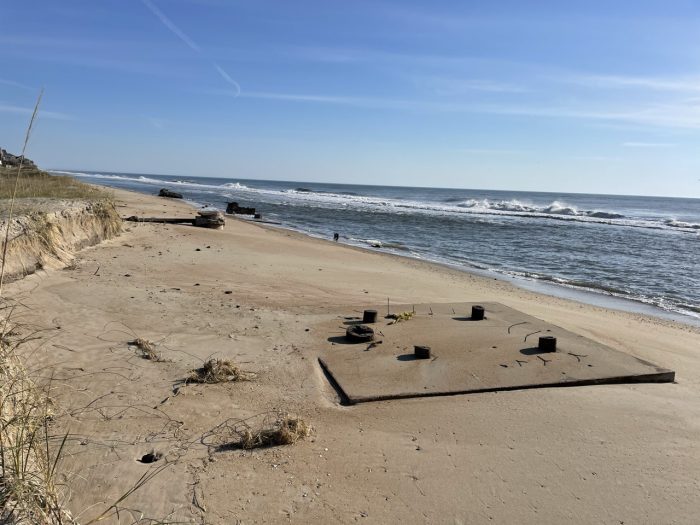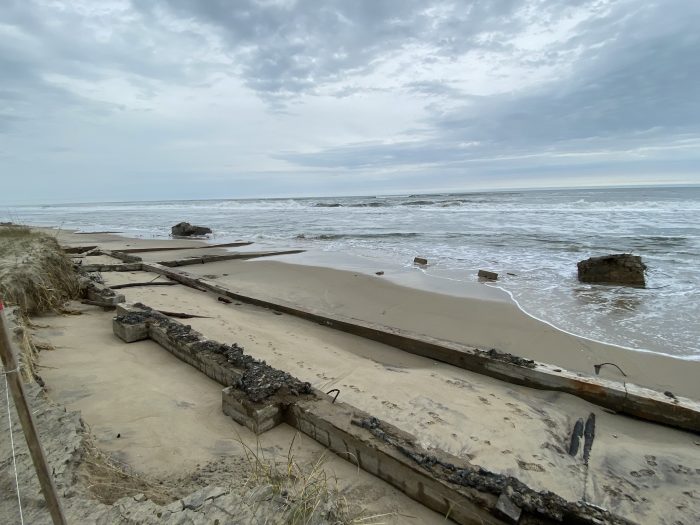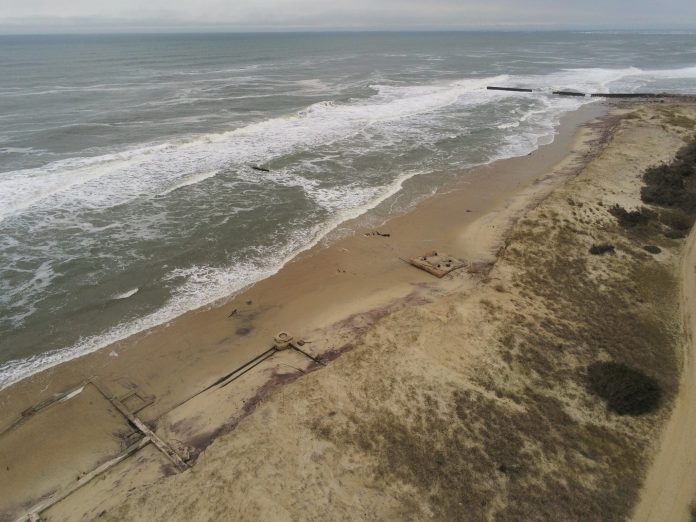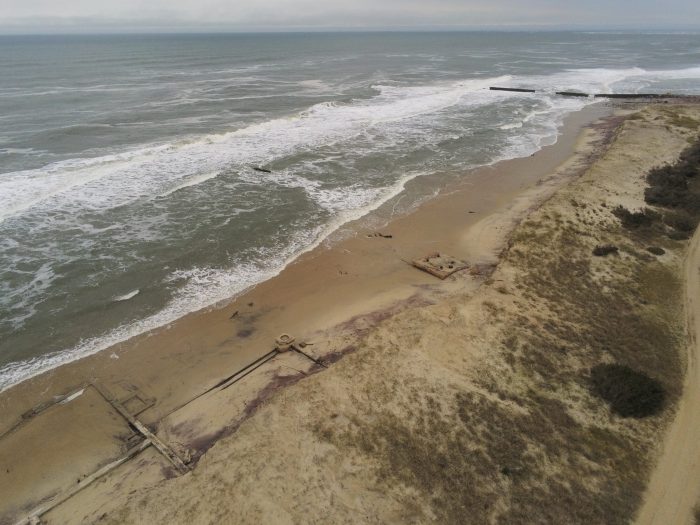
Following an energized public meeting on March 27, a local advocacy group has been formed to take action on the accelerating environmental and public safety issues that have plagued Buxton Beach for more than six months.

Although it has been less than a week since the idea of launching a community organization was initially proposed, the new Buxton Civic Association already has a nine-member Board of Directors, a social media presence, and an initial meeting scheduled for April 10, where public attendance is welcome and encouraged.
“The Buxton Civic Association will be hosting that [April 10] meeting, but David Hallac will be sharing the presentation from the last meeting as well,” said Board of Directors member Brian Harris, referring to the presentation that Hallac, Cape Hatteras National Seashore (CHNS) Superintendent, gave at the March 27 public meeting. “Everyone needs to come out and see what he has to say, and to learn where we are now.”
The new Board of Directors includes a cross-section of Buxton residents.
“There are multiple generations that are coming to the table, and the Buxton community is well represented,” said Harris. “We have surfers, fishermen, business owners, [a member] who has helped manage several North Carolina Senate campaigns… It’s a good group, and I think what we have here is a positive think tank for Buxton.”
“The biggest thing is that we need to get this information out there, and people need to start pushing this,” added Harris. “A lot of people are scared of how this will affect the tourist season, but people need to start standing behind this issue and waking up, because it’s not looking real good right now. People need to put their opinions to work, and come out and help.
A quick background on Buxton Beach and the current issues
The beach that has caused a community uproar is a small, three-tenths-of-a-mile stretch of shoreline that has been closed to the public since early September 2023.
Once the site of a military base, leftover infrastructure was buried under the beach until two offshore hurricanes – Idalia and Franklin – brushed the Outer Banks in September 2023, causing old debris and new petroleum smells and sheens to be exposed.
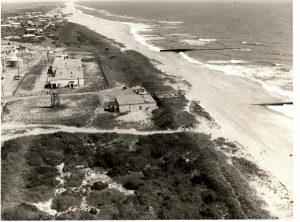
The roughly 50-acre site served as a Navy base from 1956 until 1982, under a special use permit issued by the National Park Service that said the Navy had to return the site to its pristine national seashore condition when the facilities were no longer in use.
The U.S. Coast Guard took over the site from 1984 until 2010 under a similar agreement that stated all leftover infrastructure and pollutants would be removed once the military facilities were decommissioned.
The consensus is that based on this former military use, and former agreements, the current problems at Buxton Beach should be remediated by two agencies.
The U.S. Army Corps of Engineers (USACE) is responsible for the Navy-related petroleum contamination and the mess of infrastructure on the shoreline, while the U.S. Coast Guard is responsible for a separate issue of pesticides and PCBs, (manmade organic chemicals consisting of carbon, hydrogen, and chlorine atoms), which are likely linked to Coast Guard activities in the area.
Attempts to remediate and clean the beach by both agencies have been made before.
In 1998, the USACE approved the Buxton Beach area as a Formerly Used Defense (FUDS) site, which paved the way for remediation efforts.
“The [FUDS] Program addresses environmental liabilities that resulted from Department of Defense activities at eligible properties,” stated Cheri Pritchard, Media Relations Chief for the Corps’ Savannah District in an email to Island Free Press on Feb. 12. “To be eligible, the property must have been under the control of the Department of Defense prior to and transferred out of the Department of Defense control by Oct. 17, 1986.”
Based on reports from the Crops, seven above-ground storage tanks (ASTs) and 27 underground storage tanks (USTs), were removed from the site in the 1990s. The USACE also demolished a number of structures that were not being used by the Coast Guard, including the former Driftwood Club and the Terminal Building, but evidently, not all of these structural elements were completely removed from the shoreline, based on the recent resurfacing of the buildings’ foundations.

More than 4,000 tons of petroleum-contaminated soils (PCS) were also excavated and removed from the site by the USACE in the 2000s.
Meanwhile, the Coast Guard removed a good chunk of the structures they had used during their years of operation, and while the Coast Guard removed some of the wastewater facilities in 2012, they did not remove or remediate the two drain fields that were supposed to be addressed, per the Comprehensive Environmental Response Compensation, and Liabilities Act (CERCLA) process.
In late October 2023, after these hazards resurfaced, the U.S. Army Corps of Engineers Savannah District announced that they were working on investigative efforts to determine “any necessary corrective actions” under the umbrella of the FUDS program. However, in February 2024, (and after a months-long investigation), the USACE stated that they could not find a direct source of petroleum, so they would be unable to conduct clean-up efforts.
A press release was also issued on March 27 that outlined the results of the Summary Report from the USACE’s visits to the site from September 2023 through February 2024.
“The Army Corps of Engineers will continue working with its partners to assess whether recently reported contamination is linked to DoD activities prior to 1986,” stated the March 27 press release. “However, remedial action using the FUDS Program is not authorized due to an unknown source. Additionally, the concrete structures that were uncovered after years of erosion on the beach were not associated with the petroleum or the initial cleanup of the area that occurred in the 1990s, which also means those remnants are currently ineligible for removal under the FUDS Program.”
The next steps for the Buxton Civic Association, and the public
In addition to the upcoming April 10 meeting, members of the Buxton Civic Association are taking steps to make their presence known, and to get the ball rolling.
Harris and his 10-year-old son, Sawyer, spoke to the Dare County Board of Commissioners at their monthly meeting on Tuesday, April 2, and behind the scenes, paperwork is being filed, a website is under construction, and ideas are being floated for the first waves of action.
“The first thing we will be doing is looking into the Restoration Advisory Board (RAB) program that somehow the Corps of Engineers has never talked about,” said Harris.
According to a USACE 1998 Procedures Manual, as well as a 2007 Handbook from the U.S. Secretary of Defense, the purpose of a Restoration Advisory Board (RAB) is to create a line of communication between local communities and the agencies responsible for cleaning up sites that were previously used by the Department of Defense (DoD).
“A RAB is a stakeholder group that meets on a regular basis to discuss environmental restoration at a specific property that is either currently or formerly owned by DoD, but where DoD oversees the environmental restoration process,” states the 2007 Handbook. “RABs enable people interested in the environmental cleanup at a specific [site] to exchange information with representatives of regulatory agencies, the installation, and the community… RABs offer a focused and interactive opportunity to participate in the environmental restoration process.”
Since 1994, hundreds of RABs have been established at military sites and properties across the United States.
“When I talked to everyone in Buxton, no one had ever heard of [RABs],” said Harris. “It’s a mystery how it slipped through the cracks for so long, when it has been there for 30 years. No one in Buxton was notified of the program, and there’s no excuse for that.”
“Buxton is eligible [for the formation of a RAB], and given the level of community interest, the U.S. Army Corps of Engineers, Savannah District, is mobilizing its resources to establish a Restoration Advisory Board,” stated Pritchard in an April 2 email to Island Free Press. “The District team is following the established policies and procedures regarding RAB formation. A timeline will become more apparent as we progress through the steps.”
Harris and the new Buxton Civic Association’s Board of Directors are also meeting with environmental groups in Raleigh and Washington, D.C. to garner ideas. They are simultaneously exploring options for legal remedies, and are making connections with businesses and organizations to inspire help close to home.
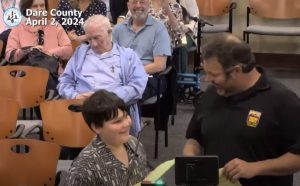
During the public comments section of Tuesday’s Board of Commissioners meeting, Sawyer Harris, (who is in the fourth grade), also proposed the idea of getting the local schools involved.
“I’m here today to tell you the beach needs to get put back together – it’s unsafe for me and everyone. Right now, there are a lot of hazards that could really hurt all of us,” said Sawyer Harris at the meeting. “I have an idea. We can get some of the school students to write letters, or posters, or make videos, or emails to show how many kids – or adults – want the beach back.”
The Buxton Civic Association has a long road ahead, but Harris points to the successful past efforts of another grassroots group, the Outer Banks Preservation Association (OPBA), which joined forces with other organizations, like the North Carolina Beach Buggy Association, to ease beach driving and beach access issues decades ago.
“We’re pretty much following John’s template for everything,” said Harris, referring to founding OBPA member John Couch, who is also advising the new Buxton Civic Association’s efforts. “Those guys did a lot of fighting, and everyone got involved and got something done. That’s what we need to do now.
“Everybody cares about this,” he added. “We’re going to explore every single option and figure something out, because ultimately, this has to be done. And everyone is enthusiastic to get started, and to get this fixed.”
For more information, and how to get involved
- The first meeting of the Buxton Civic Association will be held on Wednesday, April 10, at 6:00 p.m. at the Fessenden Center in Buxton.
- The Buxton Civic Association is in dire need of a website and social media consultant who can help build the organization’s online presence. To assist, contact Brian Harris at 252-489-9669 or via Facebook at https://www.facebook.com/buxtonnccivicassociation.
- The public can also join the ongoing email and letter-writing campaign, which was launched in mid-March by Buxton community members.
- Visitors who encounter a fuel smell or fuel sheens while visiting the Buxton shoreline near Old Lighthouse Road should call the National Response Center at 1-800-424-8802 to report the encounter. Include the date, time, location, and basic details of what was seen or smelled, and do not call if you have not experienced the issue first-hand, or have not been physically affected.
- For more information on the background of the current Buxton Beach issues, click here.
- Remember that while the environmental issues at Buxton Beach are considered to be a growing emergency, just three-tenths of a mile of the shoreline is closed, out of 75 miles of National Seashore. In short, the public can still visit and enjoy Buxton, and Hatteras Island in general.
